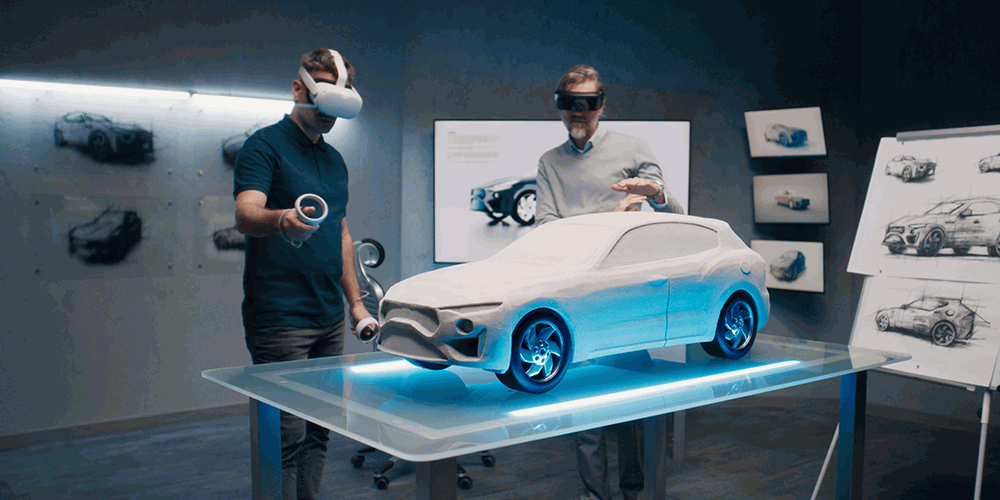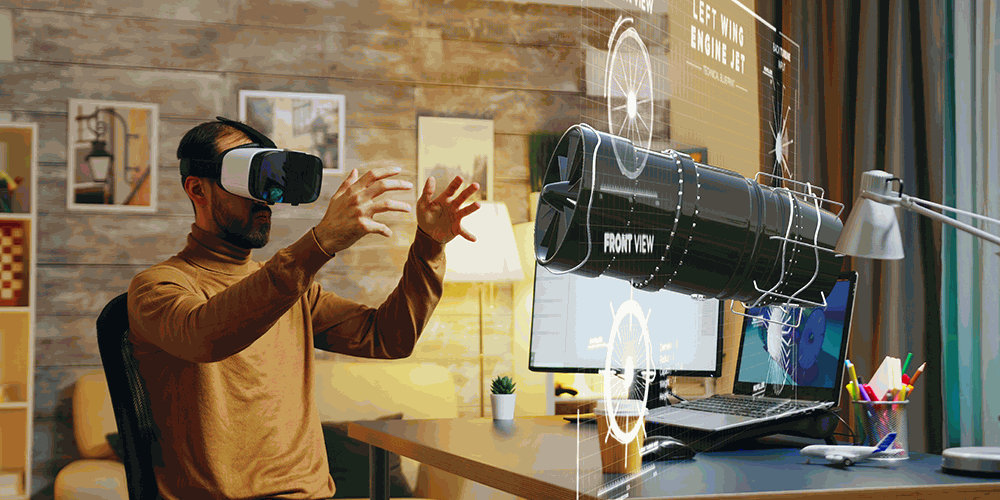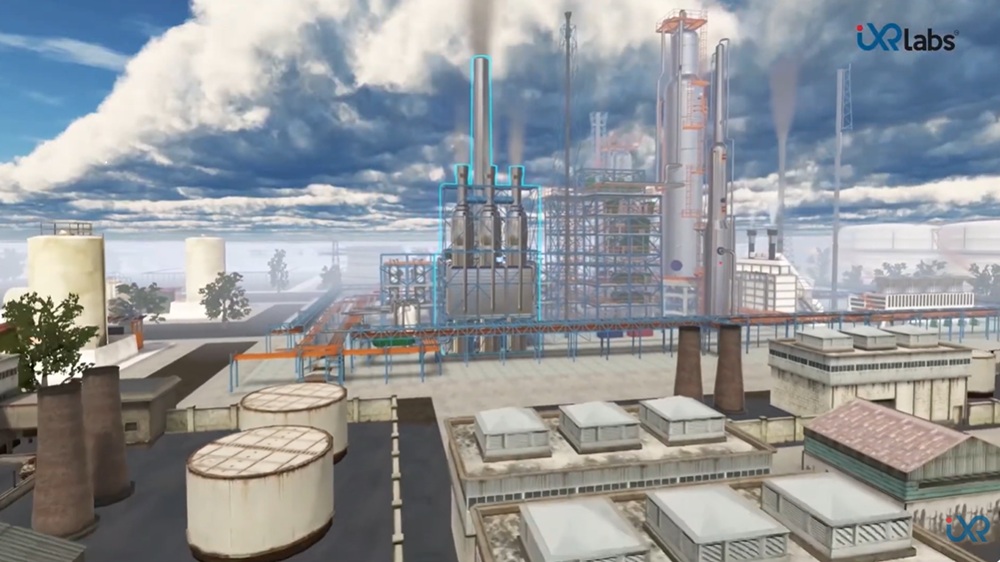How VR Can Improve Engineering Product Design?

Innovation has a way of turning what once seemed like science fiction into everyday reality. Just think about how integrating your fridge or toaster with the internet once appeared far-fetched, but today, it's quite normal.
Now, as we stand at the precipice of a new era, the integration of Virtual Reality (VR) technology into engineering product design is not an option. Instead, It has become a necessity.
You might wonder why this emerging technology should find a place in your product development roadmap, especially when current discussions around VR often revolve around the elusive Metaverse and other futuristic concepts.
Well, the truth is, that VR has evolved significantly in recent years, and their potential extends far beyond crafting avatars and navigating digital realms in development.
Today, offers tangible benefits across various industries, from consumer brands to medical device manufacturers, experienced designers, and industrial engineers.
In this blog, we will see how VR can improve engineering product design. So, let’s begin.
What is VR in Engineering?
Before we dive into the exciting world of how VR is transforming engineering product design, let's take a moment to unravel the essence of Virtual Reality (VR) itself.
VR is like a magic portal that whisks you away from your physical surroundings and plunges you into a computer-generated wonderland.
Imagine strapping on a VR headset, and suddenly, you're not in your classroom anymore – you're in a whole new digital universe. This universe feels so real that it's like you've physically teleported to another place.
And the best part?
You can interact with this digital world just like you would with the real world.
Now, it's strange but true that VR wasn't always a tool for engineers and designers. Initially, it was all about entertainment. Think of immersive video games and jaw-dropping 3D movies.
But the fascinating part is that VR's potential isn't limited to fun and games. It's like a versatile Swiss army knife that can be applied to almost any industry you can think of.
But, why is teaching engineering through modern tech like VR such a big deal in the world of engineering?
Well, its potential here is nothing short of extraordinary. Whether you're designing cutting-edge gadgets, sprawling infrastructure, or innovative machinery, VR has the power to transform the way you approach your work.
It's like giving engineers a supercharged set of tools that open up endless possibilities.
Applications of VR in Product Design

Now that we've gotten a grasp of what Virtual Reality (VR) is, let's talk about the fun stuff, i.e., how it's making waves in product design.
Imagine having a superpower that allows you to turn your wildest design ideas into tangible prototypes without even lifting a physical tool. That's the kind of magic VR brings to the table.
✔️ Streamlined Design Processes
The design process can often be riddled with bottlenecks, causing delays and frustration. As a solution to this, VR for engineering education especially product design acts as a magical elixir, banishing these bottlenecks from the workflow.
Just wear a VR headset, and you are ready to collaborate seamlessly. Also, with such technology, the decision-makers can get a crystal-clear view of how the project is progressing, all within the virtual world.
This turbocharges the design process, ensuring that your project moves forward smoothly and swiftly.
✔️ Tackling Design Challenges Head-On
Engineering often involves complex problem-solving. Virtual reality engineering equips engineers with a powerful tool that enables them to face these challenges head-on.
With VR, the students can simulate different scenarios, spot potential issues, and craft solutions, without the fear of being hurt as they are able to do all this in a safe virtual environment.
This proactive approach is proving to be radical in overcoming design obstacles.
✔️ Elevating Product Quality
Now, let's talk about quality. Well. quality is a cornerstone of any successful product. Unfortunately, the traditional design processes can sometimes result in costly discrepancies and errors.
For this issue, VR steps in as your trusty quality guardian. Now, engineers can explore every nook and cranny of a product in a virtual environment, making real-time tweaks and improvements.
Asking about the result?
Higher quality products with fewer defects, translate into happier customers and a healthier bottom line.
Amazing isn’t it?
✔️ Putting Users at the Center
Creating a product that truly meets users' needs is the Holy Grail of product design.
And, the traditional methods often fail to meet this requirement.
However,
VR takes this mission to the next level. It allows engineers to immerse users in the design process, gaining insights that traditional methods could only dream of.
This results in products that are not just functional but also user-friendly and tailored to perfection.
✔️ Collaboration Beyond Borders
What if you're part of a dynamic engineering team spread across different corners of the world?
In such a scenario, traditionally, working together on a complex project would mean endless emails, phone calls, and sometimes, hours spent on flights.
So exhausting!
But with VR for engineering product design, you can throw all that hassle out the window.
VR has the ability to bring your team together in a shared digital space, no matter where each member is located.
This not only saves your time and resources but also fosters real-time collaboration.
It's like having a virtual meeting room where you can work together as if you were in the same physical location.
✔️ Saving Costs, Boosting Efficiency
Developing and testing physical prototypes can be a costly affair.
The solution?
Yes, it's VR for product design.
With VR, engineers can create virtual prototypes that mimic real-world conditions with incredible accuracy. This not only saves your company a pretty penny but also supercharges the product development process.
Companies worldwide are witnessing significant savings in the design phase because of VR for engineering product design.
Trends in VR for Engineering Product Design
Looking ahead, the future of Virtual Reality (VR) in engineering product design is incredibly promising.
As technology relentlessly pushes boundaries, VR's role is set to evolve into something even more sophisticated and impactful.
In the near future, instead of traditional textbooks and lectures, students will get to dive headfirst into the world of engineering through VR. Think of it as a kind of magic school bus for budding engineers.
"Ready to make engineering design more awesome? Dive into VR and see how it can help you create better products! Start your journey to innovation today!"
✔️ VR for Higher Education and Engineering
VR for higher education and engineering is changing the way we teach and learn.
Let's take VR for mechanical engineering as an example. Instead of staring at complex diagrams and trying to visualize how a jet engine works, students can now virtually take it apart and see all its intricate components.
They can zoom in, rotate, and understand every part of that engine. It's like having a hands-on experience without the actual hands-on.
And it's not just mechanical engineering! Electrical engineering can benefit as well.
Imagine exploring electrical circuits and principles through immersive simulations. With VR for electrical engineering, you can see electricity flow, visualize voltage changes, and understand the behaviour of various components - all in a virtual environment. It's like having a superpower that lets you see the invisible forces at play.
✔️ Redefining Engineering Education
These developments are not just about making education more engaging.
It is redefining how we learn and teach engineering.
It's about breaking down the barriers that often make engineering seem complex and intimidating. With VR, complex concepts become approachable, and students can develop a deeper understanding by experiencing them firsthand.
For eg, while teaching jet engine in VR, students can witness real-world applications of engineering principles, all from the comfort of their classroom.
This not only enhances their learning experience but also prepares them for the practical challenges of the engineering world.
✔️ VR for Mechanical Engineering and Beyond
Mechanical engineering, known for its intricate designs and complex systems, is benefiting immensely from VR.
Engineers can delve into detailed 3D models, test mechanical systems virtually, and identify potential flaws before they become real-world problems.
But it doesn't stop there.
VR for engineering product design transcends mechanical engineering. It extends its capabilities to electrical engineering, civil engineering, and beyond.
Just like VR for mechanical engineering, each field can leverage VR to visualize and optimize its designs, resulting in more robust and efficient products.
✔️ Memory Design in VR
Intriguingly, Memory design in VR is a critical aspect of modern electronics.
Engineers can now explore the inner workings of memory modules in a virtual environment, allowing for real-time testing and modification.
This not only speeds up the design process but also ensures memory components meet the highest standards of quality and efficiency.
 Get the App from Meta Store: Download Now
Get the App from Meta Store: Download Now
Conclusion
In conclusion, VR for engineering product design is a creative powerhouse, a cost-saving wizard, and a quality assurance guru, all rolled into one.
As we continue on this technological journey, the possibilities are limitless, and the future of engineering design has never looked more promising.
So, buckle up, because VR is taking engineering product design to places we could only dream of before.
At iXR Labs we believe in the potential of integrating VR into Engineering education. We craft tailored VR modules for higher education that allow students to have an in-depth visualisation of complex concepts through Separate parts, and X-rays and Show working modes in the machinery modules.
Along with this, our modules offer remote access to industry-partnered tools in the industrial tour modules.
And, lastly, the safety of the virtual environment for performing Lab Experiments.
If you are interested in integrating such innovative technology into your institutions or are interested in knowing more about it, then you can reach out to us at namaste@ixrlabs.com or visit www.ixrlabs.com
.png)




